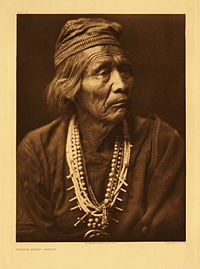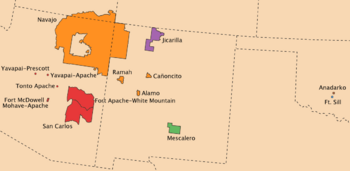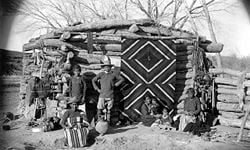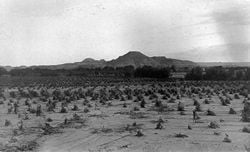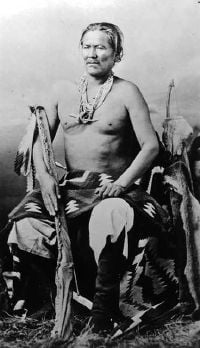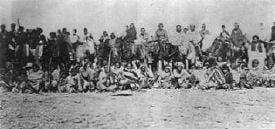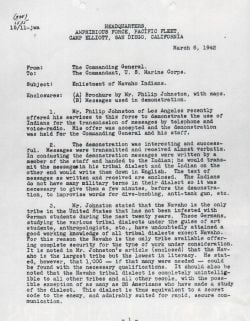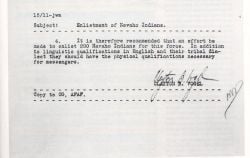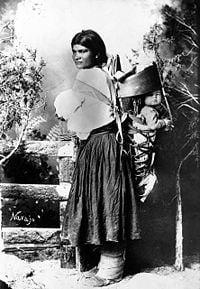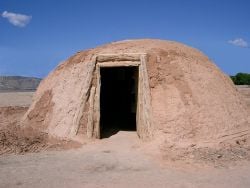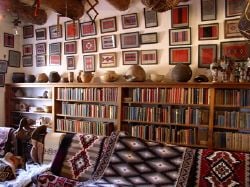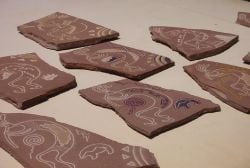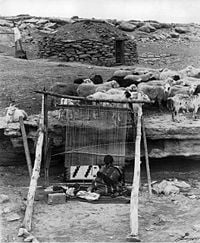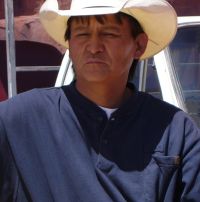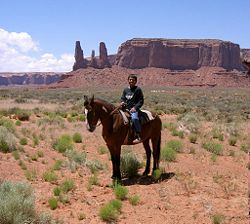Navajo
| Navajo (Diné) |
|---|
| Navajo medicine man |
| Total population |
| 338,443 (2005 census) |
| Regions with significant populations |
| United States (Arizona, New Mexico, Utah, California and Northern Mexico) |
| Languages |
| Navajo, English, Spanish |
| Religions |
| Navajo way, Christianity, Native American Church (NAC), other |
| Related ethnic groups |
| other Southern Athabascan peoples |
The Navajo (also Navaho) people of the southwestern United States call themselves the Diné (pronounced [dɪnɛ]), which roughly means "the people." They are currently the largest native American tribe in North America. They speak the Navajo language, and many are members of the Navajo Nation, an independent government structure which manages the Navajo reservation in the Four Corners area of the United States. The traditional Navajo language is still largely spoken throughout the region, although most Navajo also speak English fluently as well.
The Navajo resemble Apache in many ways, although contact with Pueblo Indians influenced their lifestyle both in terms of agriculture and art. The famous Navajo pottery, rugs, and jewelry are products of such contacts. Although the Navajo were not as persistent or extensive raiders as the Apache, they were troublesome enough for Kit Carson to subdue them. This included destruction of crops and livestock, and the forced relocation (the Long Walk) to a reservation in New Mexico which caused the death of thousands and left a legacy of resentment and distrust.
Despite this mistreatment, Navajo served the United States in the valuable role as code talkers during twentieth century wars. Today, Navajo govern themselves in the Navajo Homeland in Arizona, where their economy includes both traditional endeavors and recent innovations, including a community college which offers Diné Studies that apply Navajo principles to learning and study of their culture. Contemporary Navajo have found many ways to overcome their painful history and find their place in the emerging society that appreciates all cultures.
Name
The name Navajo comes from the late eighteenth century via the Spanish phrase (Apaches de) Navajó "(Apaches of) Navajó," which was derived from the Tewa word navahū "fields adjoining a ravine." The Navajo call themselves Diné, which is translated to mean "the people" (most Native American groups call themselves by names that mean "the people"). Nonetheless, most Navajo now acquiesce to being called "Navajo."
History
The Navajo speak dialects of the language family referred to as Athabaskan. Athabaskan speakers can also be found living in Alaska through west-central Canada and in a few areas on the Pacific coast. Linguistic and cultural similarities indicate the Navajo and the other Southern Athabaskan speakers (known today as Apaches) were once a single ethnic group (linguistically called "Apachean"). The Spanish noted the presence of a significant population in the 1500s. Navajo oral traditions are said to retain references of this migration. For example, the Great Canadian Parks website suggests that the Navajo may be descendants the lost Naha tribe, a Slavey tribe from the Nahanni region west of Great Slave Lake.[1]
Spanish explorer Coronado observed Plains people ("dog nomads") wintering near the Pueblos in established camps, who may have included Navajo. Whenever the Navajo actually arrived, they occupied areas the Pueblos peoples had abandoned during prior centuries.
Navajo oral history seems to indicate a long relationship with Pueblo people, and a willingness to adapt ideas into their own culture. Trade between the long-established Pueblo peoples and the Athabaskans was important to both groups. The Spanish records say by the mid 1500s, the Pueblos exchanged maize and woven cotton goods for bison meat, hides, and material for stone tools from Athabaskans who either traveled to them or lived around them. In the 1700s the Spanish report that the Navajo had large numbers of livestock and large areas of crops. The Navajo probably adapted many Pueblo ideas, as well as practices of early Spanish settlers, including the Churro sheep into their own very different culture.[2]
Navajos seem to have a history in the last 1000 years of expanding their range, refining their self identity, and their significance to others. In short this is probably due to a cultural combination of Endemic warfare (raids) and commerce with the Pueblo, Apache, Ute, Comanche, and Spanish people, set in the changing natural environment of the Southwest. Navajo conflicts with European invaders spanned over a 300 year period. From a Navajo perspective, Europeans were considered another tribe. Traditionally, different towns, villages, or pueblos were probably viewed as separate tribes or bands by Navajo groups.
The Spanish started to establish a military force along the Rio Grande in the 1600s to the East of Dinetah (the Navajo homeland). Spanish records indicate that Apachean groups (that might include Navajo) allied themselves with the Pueblos over the next 80 years, successfully pushing the Spaniards out of this area following the Pueblo Revolt of 1680. Raiding and trading were part of traditional Apachean and Navajo culture, and these activities increased following the introduction of the horse by the Spaniards, which increased the efficiency and frequency of raiding expeditions. The Spanish established a series of forts that protected new Spanish settlements and also separated the Pueblos from the Apacheans. The Spaniards and later Mexicans recorded what are called "punitive expeditions" among the Navajo that also took livestock and human captives. The Navajo, in turn, raided settlements far away in a similar manner. This pattern continued, with the Athapaskan groups apparently growing to be more formidable foes through the 1840s until the American Military arrived in the area.
In 1846, General Stephen W. Kearny invaded Santa Fe with 1,600 men during the Mexican War. The Navajo did not recognize the change of government as legitimate. In September, Kearny sent two detachments to raid and subdue the Navajo. Kearny later took 300 men on an expedition to California from Santa Fe. As they traveled past Navajo homelands, his force lost livestock. He ordered another expedition against the Navajo and this resulted in the first treaty with the United States government in November at Canyon de Chelly.
In the next ten years, the U.S. established forts in traditional Navajo territory. Military records state this was to protect citizens and Navajo from each other. However the old Spanish/Mexican-Navajo pattern of raids and expeditions against one another continued. New Mexican (citizen and militia) raids increased rapidly in 1860–1861 earning it the Navajo name Naahondzood, "the fearing time."
In 1861 Brigadier-General James H. Carleton, the new commander of the Federal District of New Mexico, initiated a series of military actions against the Navajo. Colonel Kit Carson was ordered by Gen. J. H. Carleton to conduct an expedition into Navajoland and receive their surrender on July 20, 1863. A few Navajo surrendered. Carson was joined by a large group of New Mexican militia volunteer citizens and these forces moved through Navajo land, killing Navajos and making sure that any Navajo crops, livestock, or dwellings were destroyed. Facing starvation, Navajos groups started to surrender in what is known as The Long Walk.
Manuelito (1818-1893) was one of the principle war chiefs of the Navajo people. He was a prominent Navajo leader who rallied Navajos against the US. Military and for several years led a group of warriors in resisting federal efforts to be removed (called the Long Walk) to Bosque Redondo, New Mexico. After going to the Bosque Redondo, he was one of the leaders who signed the treaty in 1868 enabling the Navajo to return to their four sacred mountains and to steadily increase the size of their reservation after that.
Starting in the spring of 1864, around 9,000 Navajo men, women and children were forced on The Long Walk of over 300 miles to Fort Sumner, New Mexico. Actually, there were perhaps 53 separate groups that made the walk, over the course of many months, that comprised the walk. This was the largest Reservation attempted by the U.S. government. It was a failure for a combination of reasons: it was designed (water, wood, supplies, livestock) for only 4,000–5,000 people; it had one kind of crop failure after another; other tribes and civilians were able to raid the Navajo; and a small group of Mescalero Apaches had been moved there. In 1868 a treaty was negotiated that allowed the surviving Navajos to return to a reservation that was a portion of their former range.
By treaty, the Navajo people were allowed to leave the reservation with permission to trade. Raiding by the Navajo essentially stopped, because they were able to increase the size of their livestock and crops, and not have to risk losing them to others. However, while the initial reservation increased from 3.5 million acres (14,000 km²) to the 16 million acres (65,000 km²) of today, economic conflicts with the non-Navajo continued. Civilians and companies raided resources that had been assigned to the Navajo. Livestock grazing leases, land for railroads, mining permits are a few examples of actions taken by agencies of the U.S. government who could and did do such things on a regular basis over the next 100 years. The livestock business was so successful that eventually the United states government decided to kill off most of the livestock in what is known as the Navajo Livestock Reduction.
Code talkers
Code talkers were Native American Marines serving in the United States Armed Forces who primarily transmitted secret tactical messages. The Code Talkers transmitted these messages over military telephone or radio communications nets using formal or informally developed codes built upon their native languages. Their service was very valuable since codes can be broken, but languages must be studied for a long time before being understood.
Code talking was pioneered by Choctaw Indians serving in the U.S. Army during World War I. Adolf Hitler knew about the successful use of code talkers during World War I and sent anthropologists to learn Native American languages before the outbreak of World War II. Knowing of Nazi German anthropologists' attempts to learn the languages, a large-scale code talker program was not implemented in the European Theater although a group of Comanche code talkers took part in the Invasion of Normandy in 1944, and continued to serve in the 4th Infantry Division during further European operations.
Philip Johnston proposed the use of the Navajo language to the United States Marine Corps for use in the Pacific Theater. Johnston, a World War I veteran, was raised on the Navajo reservation as the son of a missionary to the Navajos, and was one of the few non-Navajos who spoke their language fluently. Because Navajo has a complex grammar, it is not nearly mutually intelligible enough with even its closest relatives within the Na-Dene family to provide meaningful information, and was an unwritten language, Johnston saw Navajo as answering the military requirement for an undecipherable code. The idea was accepted, and the Navajo code was formally developed and centered on the Joint Army/Navy Phonetic Alphabet that uses agreed-upon English words to represent letters. For each English letter in the phonetic alphabet system the code talkers were asked to generate several nouns and sometimes verbs in Navajo using the principle of letter and word substitution. As it was determined that phonetically spelling out all military terms letter by letter into words—while in combat—would be time too consuming, some terms, concepts, tactics, and instruments of modern warfare were given uniquely formal descriptive nomenclatures in Navajo (the word for "potato" being used to refer to a hand grenade, or "tortoise" to a tank, for example).
A codebook was developed, for classroom purposes only, to teach the many relevant words and concepts to new initiates and was never to be taken into the field. The code talker was required to memorize all the English/Navajo and Navajo/English word associations in the codebook. To an ordinary Navajo speaker, the entire code-talking "conversation" would have been quite incomprehensible, because the nouns and verbs were not used in the contextual sequence for conveying meaning within Navajo sentence structure. What the uninitiated would hear were truncated and disjointed strings of individual unrelated nouns and verbs. The code talkers memorized all these variations and practiced their rapid use under stressful conditions.
The Navajo code talkers were commended for their skill, speed and accuracy accrued throughout the war. At the Battle of Iwo Jima, Major Howard Connor, 5th Marine Division signal officer, had six Navajo code talkers working around the clock during the first two days of the battle. These six sent and received over 800 messages, all without error. Connor later stated, "Were it not for the Navajos, the Marines would never have taken Iwo Jima."[3]
The Navaho Code Program was classified and remained so for many years. Although the code was never broken, the code talkers themselves were never told that, nor were they given recognition for their work during the time the program was classified. The Navajo code talkers was finally declassified in 1968.[3]
Culture
Historically, the structure of the Navajo society is largely a matrilocal system in which only women were allowed to own livestock and land. Once married, a Navajo man would move into his bride's dwelling and clan since daughters (or, if necessary, other female relatives) were traditionally the ones who received the generational inheritance (this is mirror-opposite to a patrilocal tradition). Any children are said to belong to the mother's clan and be "born for" the father's clan. The clan system is exogamous, meaning it was, and mostly still is, considered a form of incest to marry or date anyone from any of a person's four grandparents' clans.
A hogan is the traditional Navajo home. For those who practice the Navajo religion the hogan is considered sacred. Hogans are constructed to symbolize their land: the four posts represent the sacred mountains, the floor is mother earth, and the dome-like roof is father sky. The religious song "The Blessingway" describes the first hogan as being built by Coyote (a mythological character common to many Native American cultures, based on the coyote animal) with help from beavers to be a house for First Man and First Woman. Talking God gave Coyote logs and instructions on how to build the first hogan, now known as a "forked stick" or "male" hogan (ách í ádeez áhí). The door always faces east to welcome the rising sun for good wealth and fortune. The "female" hogan, built later, has a rounded form and is used as the family dwelling place. Usually a group of four or five family hogans would be constructed close together, often housing members of the extended family.
Before use a hogan must be blessed with ritual songs and prayers, and the sprinkling of cornmeal. Hogans are not permanent structures. The Navajo historically were semi-nomadic and used them for storage and shelter during the winter. In the summer they constructed simpler summer shelters that were little more than wind-breaks with a roof, one side being completely open.
Navajos made their hogans in the traditional fashion until the 1900s, when they started to make them in hexagonal and octagonal shapes. Today they are rarely used as actual dwellings, but are maintained primarily for ceremonial purposes.
Arts and craftsmanship
Turquoise has been used in jewelry by the Navajo for hundreds of years but Navajo artists did not use inlay techniques to insert turquoise into silver designs until the late nineteenth century.. Silversmithing is said to have been introduced to the Navajo while in captivity at Fort Sumner in Eastern New Mexico in 1864. At that time Atsidi Saani learned silversmithing and began teaching others the craft as well. By the 1880s Navajo silversmiths were creating handmade jewelry including bracelets, tobacco flasks, necklaces, bow guards, and their craft eventually evolved into earrings, buckles, bolos, hair ornaments, and pins.
Navajo came to the southwest with their own weaving traditions; however, they learned to weave cotton on upright looms from Pueblo peoples. These looms had no moving parts. Support poles were traditionally constructed of wood; steel pipe is more common today. The artisan sits on the floor during weaving and wraps the finished portion of fabric underneath the loom as it grows. The average weaver takes anywhere from two months to many years to finish a single rug, depending on the size. The first Spaniards to visit the region wrote about seeing Navajo blankets.
By the eighteenth century the Navajo had begun to import Bayeta red yarn to supplement local black, grey, and white wool, as well as wool dyed with indigo. Using an upright loom the Navajos made extremely fine utilitarian blankets that were collected by Ute and Plains Indians. These Chief's Blankets, so called because only chiefs or very wealthy individuals could afford them, were characterized by horizontal stripes and minimal patterning in red. First Phase Chief's Blankets have only horizontal stripes, Second Phase feature red rectangular designs, and Third Phase feature red diamonds and partial diamond patterns.
Railroad service reached Navajo lands in the early 1880s and resulted in considerable expansion of the market for Navajo woven goods. Some early European settlers moved in and set up trading posts, often buying Navajo Rugs by the pound and selling them back east by the bale. Several European-American merchants influenced Navajo weaving, encouraging the locals to weave blankets and rugs into distinct styles.
Today Navajo weaving is a fine art, and weavers opt to work with natural or commercial dyes and traditional, pictorial, or a wide range of geometric designs.
Weaving plays a role in the creation myth of Navajo cosmology, which articulates social relationships and continues to play a role in Navajo culture. According to one aspect of this tradition, a spiritual being called "Spider Woman" instructed the women of the Navajo how to build the first loom from exotic materials including sky, earth, sunrays, rock crystal, and sheet lightning. Then "Spider Woman" taught the Navajo how to weave on it.[4]
Religion
The Navajo people traditionally hold the four sacred mountains as the boundaries of Dinetah, the homeland they should never leave: Blanca Peak (Tsisnaasjini'—Dawn or White Shell Mountain) in Colorado; Mount Taylor (Tsoodzil—Blue Bead or Turquoise Mountain) in New Mexico; the San Francisco Peaks (Doko'oosliid—Abalone Shell Mountain) in Arizona; and Hesperus Mountain (Dibé Nitsaa—Big Mountain Sheep) in Colorado. Their mythology tells how they arrived in this homeland.
Creation story
The Navajo creation story, Diné Bahaneʼ, centers on the area known as the Dinetah, the traditional homeland of the Navajo people. The story has many variations but the basic outline is as follows.
Holy Supreme Wind being created the mists of lights arose through the darkness to animate and bring purpose to the myriad Holy People, supernatural and sacred in the different three lower worlds. All these things were spiritually created in the time before the earth existed and the physical aspect of man did not exist yet, but the spiritual did.
The First World was small and centered on an island floating in a the middle of four seas. The inhabitants of the first world were Diyin Dineʼé (Holy People), Coyote, mist beings, and various insect people. The supernatural beings First Woman and First Man came into existence here and met for the first time after seeing each other's fire. The various beings started fighting with one another and were instructed by the Holy People to depart. The left by flying out an opening in the east.
They journeyed to the second world which was inhabited by various blue-gray furred mammals and various birds, including blue swallows. and lived for a time in peace, but eventually they offended Swallow Chief and were instructed to depart. First Man created a wand of jet and other materials to allow the people to walk upon it up into the next world through an opening in the south.
In the third world there were two rivers that formed a cross and the Sacred Mountains but there was still no sun. More animal people lived here too. This time it was not discord among the people that drove them away but a Great Flood caused by Tééhoołtsódii when Coyote stole her child. They were forced to journey to the fourth world through a hollow reed planted on the top of the mountain which grew until it reached the canopy of the sky. The people then climbed up the hollow tube into this world which was covered in water and had monsters living here.
The Sacred Mountains were re-formed from soil taken from the original mountains in the Second World. First Man, First Woman, and the Holy People created the sun, moon, seasons, and stars. It was here that true death came into existence via Coyote tossing a stone into a lake and declaring that if it sank then the dead would go back to the previous world.
First Man and First Woman built a hogan to live and blessed it with cornmeal ground by First Woman, saying, "May my home be sacred and beautiful, and may the days be beautiful and plenty." This was the first hogan-raising ceremony.
The first human born in the fourth world was Asdzą́ą́ Nádleehé who, in turn, gave birth to the Hero Twins called Naayééʼ Neizghání and Tóbájíshchíní. The twins had many adventures in which they helped to rid the world of various monsters. The Diyin Dineʼé gave them ceremonies which are still practiced today.
Healing and spiritual practices
Navajo spiritual practice is about restoring health, balance, and harmony to a person's life. Ceremonies restore Hozhò, or beauty, harmony, balance, and health. Examples include the Hooghan Blessing Ceremony, the "Baby's First Laugh Ceremony," and the Beauty Way ceremony: the Kinaaldá, or a female puberty ceremony.
The most important of the Navajo spiritual ceremonies is the Blessingway [Hózhóojí] ceremony. It is performed in the sacred Hogan, and the chant recounts the Navajo creation story. The ceremony is to ensure good luck, good health, harmony, and success. The song at the conclusion of the ceremony includes four holy words that are repeated Sa'ah naaghéi, Bik'eh hózhoó which correct any errors in the ceremony, assure the pleasure of the Holy People (diyin diné), and remind everyone of the ideals of the Navajo culture.[5]
Other ceremonies are used to heal illnesses, strengthen weakness, and give vitality to the patient. When suffering from illness or injury, Navajos will traditionally seek out a certified, credible Hatałii (medicine man) for healing, before turning to Western medicine. The medicine man will use several methods to diagnose the patient's ailments. This may include using special tools such as crystal rocks, and abilities such as hand-trembling and Hatał (chanting prayer). The medicine man will then select a specific healing chant for that type of ailment. Short blessings for good luck and protection may only take a few hours, and in all cases, the patient is expected to do a follow-up afterwards. This may include the avoidance of sexual relations, personal contact, animals, certain foods, and certain activities. This is done to respect the ceremony.
The origin of spiritual healing ceremonies dates back to Navajo mythology. It is said the first Enemy Way ceremony was performed for Changing Woman's twin sons (Monster Slayer and Born-For-the-Water) after slaying the Giants (the Yé'ii) and restoring Hozhó to the world and people. The patient identifies with Monster Slayer through the chants, prayers, sandpaintings, herbal medicine, and dance.
There are said to be approximately 58 to 60 sacred ceremonies. Most of them last four days or more; to be most effective, they require that relatives and friends attend and participate. Outsiders are often discouraged from participating, in case they become a burden on everyone, or violate a taboo, which could affect the outcome of the ceremony. The ceremony must be done in precisely the correct manner to heal the patient, and this includes everyone that is involved.
Training a Hatałii to perform ceremonies is extensive, arduous, and takes many years. The apprentice learns everything by watching his teacher, and memorizes the words to all the chants. Many times, a medicine man cannot learn all 60 of the ceremonies, so he will opt to specialize in a select few.
Another Navajo healing, the Night Chant ceremony, is administered as a cure for most types of head ailments, including mental disturbances. The ceremony, conducted over several days, involves purification, evocation of the gods, identification between the patient and the gods, and the transformation of the patient. Each day entails the performance of certain rites and the creation of detailed sand paintings. On the ninth evening a final all-night ceremony occurs, in which the dark male thunderbird god is evoked in a song that starts by describing his home:
- In Tsegihi [White House],
- In the house made of the dawn,
- In the house made of the evening light[6]
The medicine man then proceeds by asking the Holy People to be present, identifying the patient with the power of the god, and describing the patient's transformation to renewed health with lines such as "Happily I recover."[6] The same dance is repeated throughout the night, about 48 times. Altogether the Night Chant ceremony takes about ten hours to perform, and ends at dawn.
Skin-walkers
A "skin-walker" is a person with the supernatural ability to turn into any animal he or she desires. Similar creatures can be found in numerous cultures' lores all over the world.
The ’ánt’įįhnii are human beings who have gained supernatural power by breaking a cultural taboo. Specifically, a person is said to gain the power to become a Yea-Naa-gloo-shee upon initiation into the Witchery Way. Both men and women can become ’ánt’įįhnii and therefore possibly skinwalkers, but men are far more numerous. It is generally thought that only childless women can become witches.
Although it is most frequently seen as a coyote, wolf, owl, fox, or crow, the Yea-Naa-gloo-shee is said to have the power to assume the form of any animal they choose, depending on what kind of abilities they need. A skin-walker is usually described as naked, except for a coyote skin, or wolf skin. Some Navajos describe them as a mutated version of the animal in question. The skin may just be a mask, like those which are the only garment worn in the witches' sing. Because animal skins are used primarily by skin-walkers, the pelt of animals such as bears, coyotes, wolves, and cougars are strictly tabooed. Sheepskin and buckskin are probably two of the few hides used by Navajos, the latter is used only for ceremonial purposes.
It is said that if a Navajo was to know the person behind the skinwalker they had to pronounce the full name. About three days later that person would either get sick or die for the wrong that they have committed.[7]
According to Navajo legend, skin-walkers can have the power to read human thoughts. They also possess the ability to make any human or animal noise they choose. A skinwalker may use the voice of a relative or the cry of an infant to lure victims out of the safety of their homes.
Traditional Navajo music is always vocal, with most instruments, which include drums, drumsticks, rattles, rasp, flute, whistle, and bullroarer, being used to accompany singing of specific types of song. Only Hataałii, or Singers otherwise known as 'Medicine People', are qualified to sing the 30 ceremonials and countless prayer rituals which restore hozhó or harmonious condition, good health, serenity, and balance. These songs are the most sacred holy songs, the "complex and comprehensive" spiritual literature of the Navajo, while all other songs, including personal, patriotic, daily work, recreation, jokes, and less sacred ceremonial songs, may be considered popular music. The "popular" side is characterized by public performance while the holy songs are preserved of their sacredness by reserving it only for ceremonies.
The longest ceremonies may last up to nine days and nights while performing rituals that restore the balance between good and evil, or positive and negative forces. The hataałii, aided by sandpaintings or masked yeibicheii, as well as numerous other sacred tools used for healing, chant the sacred songs to call upon the Navajo gods and natural forces to restore the person to harmony and balance within the context of the world forces. In ceremonies involving sandpaintings, the person to be supernaturally assisted, the patient, becomes the protagonist, identifying with the gods of the Diné Creation Stories, and at one point becomes part of the Story Cycle by sitting on a sandpainting with iconography pertaining to the specific story and deities.
The lyrics, which may last over an hour and are usually sung in groups, contain narrative epics including the beginning of the world, phenomenology, morality, and other lessons. Longer songs are divided into two or four balanced parts and feature an alternation of chantlike verses and buoyant melodically active choruses concluded by a refrain in the style and including lyrics of the chorus. Lyrics, songs, groups, and topics include cyclic: Changing Woman, an immortal figure in the Navajo traditions, is born in the spring, grows to adolescence in the summer, becomes an adult in the autumn, and then an old lady in the winter, repeating the life cycles over and over. Her sons, the Hero Twins, Monster Slayer and Born-for-the-Water, are also sung about, for they rid the world of giants and evil monsters. Stories such as these are spoken of during these sacred ceremonies.
Children's songs
Navajo children's songs are usually about animals, such as pets and livestock. Some songs are about family members, and about chores, games, and other activities as well. It usually includes anything in a child's daily life. A child may learn songs from an early age from the mother. As a baby, if the child cries, the mother will sing while the baby stays tied in the cradleboard. Navajo songs are rhythmic, and therefore soothing to a baby. Thus, songs are a major part of Navajo culture.
In children's songs, a short chant usually starts off the song, followed by at least one stanza of lyrics, and finishing up with the same chant. All traditional songs include chants, and are not made up solely of lyrics. There are specific chants for some types of songs as well. Contemporary children's songs, however, such as Christmas songs and Navajo versions of nursery rhymes, may have lyrics only. Today, both types of songs may be taught in elementary schools on the reservation, depending on the knowledge and ability of the particular teacher.
In earlier times, Navajo children may have sung songs like these to themselves while sheepherding, to pass the time. Sheep were, and still are, a part of Navajo life. Back then, giving a child custody of the entire herd was a way to teach them leadership and responsibility, for one day they would probably own a herd of their own. A child, idle while the sheep grazed, may sing to pass the time.
Peyote songs
Peyote songs are a form of Native American music, now most often performed as part of the Native American Church, which came to the northern part of the Navajo Nation around 1936. They are typically accompanied by a rattle and water drum, and are used in a ceremonial aspect during the sacramental taking of peyote. Peyote songs share characteristics of Apache music and Plains-Pueblo music.
Contemporary popular
The Navajo music scene is perhaps one of the strongest in native music today. In the past, Navajo musicians maintained the status quo of traditional music, chants and/or flute compositions. Today, Navajo bands span the genres of including punk, hip hop, blues, rock, country, and even traditional. Success of a number of Navajo bands and other musicians have reignited an interest in music with the younger Navajo generations. Perhaps the best synthesis of tradition and contemporary is found in the musical marriage of Tribe II Entertainment, a rap duo from Arizona, who are the only Native American rappers who can rap entirely in their native tongue. Their popularity and bilingual ability is yet another look at the prolific nature of the Navajo music scene.
The Navajo Nation (Diné) encompasses all things important to the Navajo—the land, kinship, language, religion, and the right to govern themselves. The Navajo Homeland covers about 26,000 square miles (70,000 square kilometres, 17 million acres) of land, occupying all of northeastern Arizona, and extending into Utah and New Mexico, and is the largest land area assigned primarily to a Native American jurisdiction within the United States.
Their government is unique in several ways. The Navajo Nation is divided into five Agencies. These are similar to counties and match the five Bureau of Indian Affairs (BIA) agencies which support the Nation. The smallest political units are the Chapters, similar to towns. The Navajo Nation Council are elected every four years by registered Navajo voters. As reorganized in 1991, the Nation's government at the capital in Window Rock has a three branch system: Executive, Legislative, and Judicial. The United States still asserts plenary power to require the Navajo Nation to submit all proposed laws to the United States Secretary of the Interior for Secretarial Review, through the Bureau of Indian Affairs.
The Navajo governing council continues a historical practice of prohibiting alcohol sales within reservation boundaries. For some visitors of the area — often attracted by the Indian jewelry trade, by tourist attractions or by Interstate Highway 40 that passes through the area. Leaders and some member groups actively oppose the sale of alcohol, and have taken several measures to find and offer treatment for those members who are suffering from alcoholism.
There is no private land ownership within the Navajo Nation - all land is owned in common and administered by the Nation's government. Leases are made both to customary land users (for homesites, grazing, and other uses) and to organizations, including the BIA and other federal agencies, churches and other religious organizations, and businesses.
The Navajo Nation economy includes traditional endeavors such as sheep and cattle herding, fiber production, weaving, jewelry making, and art trading. Newer industries that employ members include coal and uranium mining, though the uranium market slowed near the end of the twentieth century. The Navajo Nation's extensive mineral resources are among the most valuable held by Native American nations within the United States. The Navajo government employs hundreds in civil service and administrative jobs. One important business within the reservation is the operation of arts and crafts shops, selling handmade crafts. Other Navajo members work at retail stores and other businesses within the Nation's reservation or in nearby towns.
Until 2004, the Navajo Nation had declined to join other Native American nations within the United States who have opened casinos. That year, the nation signed a compact with the state of New Mexico to operate their first casino at To'hajiilee, near Albuquerque.
Most modern housing in the Navajo Nation is detached single-family homes and mobile homes. Most homes in the Navajo Nation were built in the 1960s, 1970s, or 1980s, although older built homes do exist. Single-family homes are mostly rural-styled homes constructed of wood. Because many homes do not have access to natural gas and electricity, most homes use wood or propane for heat and cooking.
Due to the reservation's remote geographic location, many structures do not have telephone or public utility services and lack complete kitchen or plumbing facilities. However, infrastructure development has grown significantly through the years, affording Navajo families the modern conveniences of DSL, satellite television, and even wireless internet access in some communities. The government subsidized phone program has brought even the most remote locations of the reservation in contact with the rest of the Navajo Nation.
The Navajo Nation operates Diné College, a two-year community college which has its main campus in Tsaile in Apache County, as well as seven other campuses on the reservation. Current enrollment is 1,830 students, of which 210 are degree-seeking transfer students for four-year institutions. The college includes the Center for Diné Studies, whose goal is to apply Navajo Sa'ah Naagháí Bik'eh Hózhóón principles to advance quality student learning through Nitsáhákees (thinking), Nahatá (planning), Iiná (living), and Sihasin (assurance) in study of the Diné language, history, and culture in preparation for further studies and employment in a multi-cultural and technological world.
Notes
- ↑ Cultural Heritage "Nahanni National Park Reserve," Great Canadian Parks. Retrieved May 16, 2020.
- ↑ Diné be' Iiná navajolifeway.org. Retrieved May 16, 2020.
- ↑ 3.0 3.1 Sandi Gohn, How Navajo Code Talker Marines Used Their Indigenous Language to Help Win World War II USO. Retrieved May 16, 2020.
- ↑ Kathy M’Closkey, Towards an Understanding of Navajo Aesthetics S.E.E.D. Journal 4(1) (2004): 91-117. Retrieved May 16, 2020.
- ↑ Charlotte J. Frisbie and David P. McAllester (eds.), Navajo Blessingway Singer: The Autobiography of Frank Mitchell, 1881-1967 (Tucson, AZ: University of Arizona Press, 2003, ISBN 978-0826331816).
- ↑ 6.0 6.1 Donald Sandner, Navaho Symbols of Healing (Healing Arts Press, 1991, ISBN 978-0892814343).
- ↑ Clyde Kluckhohn, Navaho Witchcraft (Boston, MA: Beacon Press, 1970, ISBN 978-0807046975).
Bibliography
- Bailey, L. R. The Long Walk: A History of the Navaho Wars, 1846–1868. Westernlore Press, 1964. ASIN B002974YDG
- Bierhorst, John (ed.). Four Masterworks of American Indian Literature (includes "Night Chant"). University of Arizona Press, 1984. ISBN 0816508860
- Bighorse, Tiana. Bighorse the Warrior. Tucson, AZ: University of Arizona Press, 1994. ISBN 978-0816514441
- Bixler, Margaret T. Winds of Freedom: The Story of the Navajo Code Talkers of World War II. Darien, CT: Two Bytes Publishing Company, 1995. ASIN B000IB3PXA
- Brady, M. K. Some Kind of Power: Navaho Children's Skinwalker Narratives. Salt Lake City, UT: University of Utah Press, 1984. ISBN 0874802385
- Brown, Dee. Bury My Heart at Wounded Knee. Macmillan, 1970. ISBN 0330232193
- Brugge, David M. Navajos in the Catholic Church Records of New Mexico 1694–1875. Window Rock, AZ: Research Section, The Navajo Tribe, 1968.
- Clarke, Dwight L. Stephen Watts Kearny: Soldier of the West. Norman, OK: University of Oklahoma Press, 1961. ASIN B000NV6PPK
- Downs, James F. The Navajo. Long Grove, IL: Waveland Press, 1984. ISBN 978-0881330373
- Dyke, Walter. Son of Old Man Hat: A Navaho Autobiography. Lincoln, NE: University of Nebraska Press, 1967. ISBN 978-0803250543
- Forbes, Jack D. Apache, Navajo and Spaniard. Norman, OK: University of Oklahoma Press, 1971. ASIN B000KGLDLY
- Frisbie, Charlotte J., and David P. McAllester (eds.). Navajo Blessingway Singer: The Autobiography of Frank Mitchell, 1881-1967. Tucson, AZ: University of Arizona Press, 2003. ISBN 978-0826331816
- Gilpin, Laura. The Enduring Navaho. Austin, TX: University of Texas Press, 1987. ISBN 978-0292720589
- Gold, Peter. Navajo & Tibetan Sacred Wisdom: The Circle of the Spirit. Rochester, VT: Inner Traditions International, 1994. ISBN 089281411X
- Hammond, George P. and Agapito Rey, (eds.). Narratives of the Coronado Expedition 1540–1542. Albuquerque, NM: University of New Mexico Press, 1940.
- Henderson, Richard. “Replicating Dog Travois Travel on the Northern Plains.” Plains Anthropologist 39(1994): 145–159.
- Iverson, Peter. Diné: A History of the Navahos. Albuquerque, NM: University of New Mexico Press, 2002. ISBN 0826327141
- Johnson, Broderick. (ed). Navajo Stories of the Long Walk Period. Dine Press, 1975. ISBN 978-0912586168
- Johnson, Broderick, and Ruth Roessel. Navajo Livestock Reduction: A National Disgrace. Tsaile, AZ: Navajo Community College Press, 1974. ISBN 0912586184
- Kelly, Lawrence. Navajo Roundup. Pruett Pub. Co., 1970. ISBN 978-0871080424
- Kluckhohn, Clyde. Navaho Witchcraft. Boston, MA: Beacon Press, 1970. ISBN 978-0807046975
- Kluckhohn, Clyde, and Dorothea Leighton. The Navaho. Cambridge, MA: Harvard University Press, 1992. ISBN 978-0674606036
- Kriss, Marika. Werewolves, Shapeshifters and Skinwalkers. Los Angeles, CA: Sherbourne Press, 1972. ISBN 978-0820201528
- Loewen, James. W. Lies Across America. New York: Simon & Schuster/Touchstone, 2007. ISBN 978-0743296298
- McPherson, Robert S. Sacred Land, Sacred View: Navajo perceptions of the Four Corners Region. Brigham Young University, ISBN 1560850086.
- McNitt, Frank. Navajo Wars: Military Campaigns, Slave Raids, and Reprisals. Albuquerque, NM: University of New Mexico Press, 1990. ISBN 978-0826312266
- Newcomb, Franc Johnson. Hosteen Klah: Navaho Medicine Man and Sand Painter. Norman, OK: University of Oklahoma Press, 1980. ISBN 978-0806110080
- Plog, Stephen. Ancient Peoples of the American Southwest. London & New York: Thames and London, Ltd, 1997. ISBN 050027939X.
- Pritzker, Barry M. A Native American Encyclopedia: History, Culture, and Peoples. New York, NY: Oxford University Press, 2000. ISBN 0195138775
- Salmonson, Jessica Amanda. The Encyclopedia of Amazons. Minneapolis, MN: Paragon House, 1991. ISBN 1557784205
- Sandner, Donald. Navaho Symbols of Healing. Healing Arts Press, 1991. ISBN 978-0892814343
- Teller, J. The Navajo Skinwalker, Witchcraft, & Related Spiritual Phenomena: Spiritual Clues: Orientation to the Evolution of the Circle. Chinle, AZ: Infinity Horn Publishing, 1997 ISBN 0965601404
- Terrell, John Upton. The Navajos: the Past and Present of a Great People the Story of the Largest Indian Tribe in America. New York, NY: Weybright and Talley, 1970. ASIN B000H42Q74
- Thybony, Scott. The Hogan: The Traditional Navajo Home. Southwest Parks & Monuments Association, 1998. ISBN 1877856932
- Underhill, Ruth M. The Navahos. Norman, OK: The University of Oklahoma Press, 1983. ISBN 978-0806118161
- Waldman, Carl. Atlas of the North American Indian, Revised Edition. New York, NY: Checkmark Books, 2000. ISBN 0816039755
- Waldman, Carl. Encyclopedia of Native American Tribes. New York, NY: Checkmark Books, 2006. ISBN 9780816062744
- Wall, Leon, and William Morgan. Navajo-English Dictionary. New York, NY: Hippocrene Books, 1998. ISBN 0781802474
- Witherspoon, Gary. Language and Art in the Navajo Universe. Ann Arbor. MI: University of Michigan Press, 1990. ASIN B000VBDUAK
- Wyman, Leland C. Blessingway. Tucson, AZ: University of Arizona Press, 1970. ISBN 978-0816501786
- Young, Robert W. and William Morgan. Colloquial Navajo, a Dictionary. New York, NY: Hippocrene Books, 1998. ISBN 0781802784
- Zolbrod, Paul G. Diné bahané: The Navajo Creation Story. Albuquerque, NM: University of New Mexico Press, 1987. ISBN 978-0826310439
External links
All links retrieved November 11, 2022.
- Navajo People information by State of Utah
- Navajo People - The Diné
- Navajo Silversmiths, by Washington Matthews, 1883 from Project Gutenberg
- Navajo Jewelry
- The Navajo Internet Sacred Text Archive
- Discover Navajo
- Official Website of the Navajo Code Talkers
- Navajo Arts
Credits
New World Encyclopedia writers and editors rewrote and completed the Wikipedia article in accordance with New World Encyclopedia standards. This article abides by terms of the Creative Commons CC-by-sa 3.0 License (CC-by-sa), which may be used and disseminated with proper attribution. Credit is due under the terms of this license that can reference both the New World Encyclopedia contributors and the selfless volunteer contributors of the Wikimedia Foundation. To cite this article click here for a list of acceptable citing formats.The history of earlier contributions by wikipedians is accessible to researchers here:
- Navajo_people history
- Navajo_mythology history
- Navajo_music history
- Witch_(Navajo) history
- Skin-walker history
The history of this article since it was imported to New World Encyclopedia:
Note: Some restrictions may apply to use of individual images which are separately licensed.
